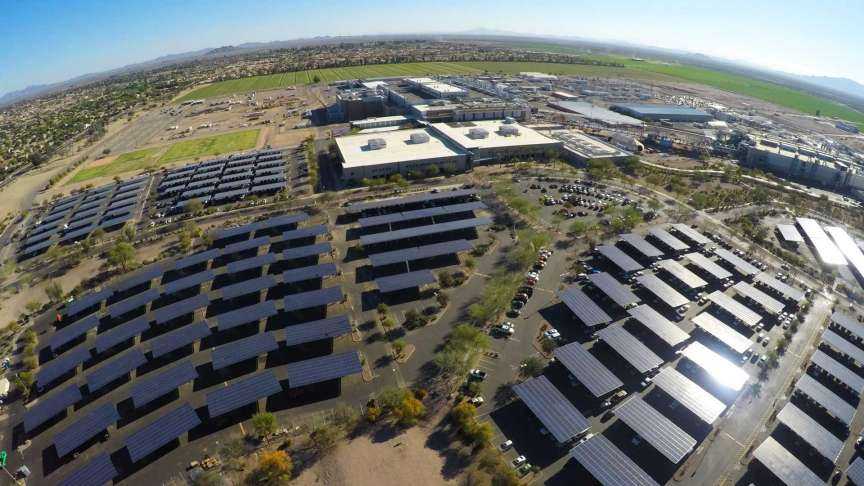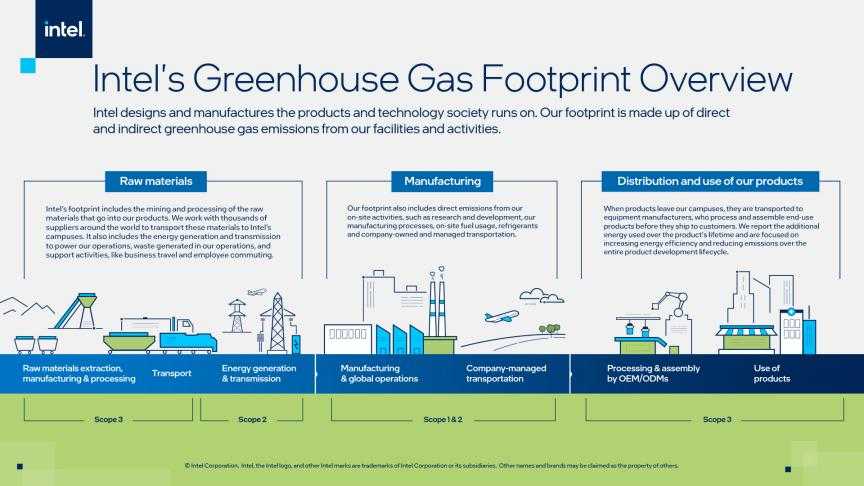
Intel today announced plans to further reduce its direct and indirect greenhouse gas emissions. By 2040, the company is committed to achieving net zero
Intel undertakes to reach by 2040 net zero greenhouse gas emissions for all its operations. The company’s priority is to actively reduce emissions, in line with the international standards and with the indications of expert scientists in the study of the climate. Recourse to offsetting with credible carbon to achieve the target, if necessary, can only be done as a last resort.
To increase energy efficiency and to reduce the environmental impact of Intel products and platforms, by setting specific goals, and to work with customers and partners to create solutions that reduce the environmental impact of the entire technology ecosystem. In fact, Intel’s words are clear and decisive on the objective of what increasingly in recent years has become a decisive issue to be dealt with;
Intel’s plan sets goals for reducing the environmental impact of the supply chain and promoting industry-wide initiatives to address climate change.
Intel and its goal of achieving zero emissions by 2040
Recourse to offsetting with credible carbon to achieve the target, if necessary, can only be done as a last resort. To achieve this ambitious goal, Intel has set itself the following milestones for 2030:
- Use 100% renewable energy in all its operations globally
- Invest around $ 300 million in reducing consumption to achieve cumulative savings of 4 billion kWh
- Build new factories and factories in compliance with the standards set by the US Green Building Council® LEED® program, including those recently announced as part of investments in the US, Europe and Asia.
- Launch a research and development initiative involving the entire sector to identify chemical compounds with a lower environmental impact, and to develop new technologies to reduce emissions.
These goals reinforce Intel’s commitment to sustainable business practices, such as the RISE strategy. Intel’s cumulative greenhouse gas emissions over the past decade decreased by almost 75% than they would have been had these investments not been made and these actions taken.
The impact of climate change is an urgent global problem. Protecting our planet requires immediate action and a new way of thinking about how the world works. As a leading semiconductor design and manufacturing company, Intel is uniquely positioned to make a difference, not only in its operations, but also by helping customers, partners and the entire value chain take meaningful action.
These are the words of Pat GelsingerCEO Intel.
Intel is also committed to addressing climate impacts upstream and downstream of its value chain by reducing the Scope 3 emissions. Intel’s strategy to reduce Scope 3 emissions is based on the collaboration with partners and customers to take meaningful actions aimed at reducing greenhouse gas emissions.

As for the supply chain of Intel, we know it is actively engaged with its partners to identify areas for improvement, including increased supplier attention to energy saving and renewable energy supply, increased efficiency in the use of chemicals and resources, and the establishment of intersectoral consortia to support the transition to net zero greenhouse gas emissions semiconductor production. Intel commits to work with partners to reduce supply chain greenhouse gas emissions by at least 30% by 2030 than they would be in the absence of investments and shares. So he also states Keyvan Esfarjaniexecutive vice president and chief global operations officer di Intel;
Intel has been a leader in sustainability for decades, and this position carries with it responsibilities. We are now raising the bar and entering an exciting era of achieving net zero greenhouse gas emissions in our operations by 2040. This will require significant innovation and investment, but we are committed to doing what it takes and will work with the industry. to achieve this fundamental objective
To achieve customers’ sustainability goals and reduce Scope 3 greenhouse gas emissions in the use of technology, Intel will increase the energy efficiency of its products by continuing to improve their performance in line with market demands. Intel has set itself the goal of increasing performance per Watt by five times for its next generation CPU-GPUs. Falcon Shores. The company continues in its commitment to increase of 10 times the energy efficiency of client and server microprocessor products by 2030.

To help customers reduce their emissions, Intel is innovating in the following directions:
- The layout, selection and modularity of all internal components to reduce the size of the main boards.
- Continuous increases in system energy efficiency and display efficiency to significantly reduce overall energy consumption.
- The use of bio-based printed circuit boards to aid in the separation of materials and components during recycling and to reduce WEEEE waste.
Intel also has set a target of reducing emissions from platform projects by 30% or more by 2030 reference for customers’ products. These efforts are taking shape with the device prototype Dell Luna Concept, developed in collaboration with Intel to show future possibilities for sustainability in PC design. All time Glen RobsonChief Technology Officer Client Solutions Group, di Dell Technologies;
Collaboration is key if we are to find solutions to the environmental problems we all face. Intel has been an important partner in this regard, helping us drive joint innovation by supporting motherboard optimization, developing bio-based printed circuit boards, and increasing system energy efficiency in our Concept Luna device. The ambition behind this ongoing work is to test, demonstrate and evaluate the opportunities to implement innovative and sustainable ideas on a large scale in our product portfolio – it is the only way we will be able to boost the circular economy and protect our planet for generations to come
By collaborating with hundreds of customers and partners in the sector to create solutions that meet the need for ever-increasing computing power while obtaining greater efficiency and lower consumption. For example, Intel is collaborating to launch pilot immersion liquid-cooled data center deployments with companies such as Submer. This process includes the adoption of new principles, such as the recovery and reuse of heat through immersion cooling.
He claims Daniel Popeco-founder and CEO of Submer, who 99% of the heat generated by IT equipment it can be captured in the form of hot water, with virtually no leaks and at much higher temperatures. Thanks to the partnership with Intel, Submer is able to take its immersive cooling solutions to a larger scale favoring energy savings and at the same time capturing thermal energy to reuse it. This will fundamentally change the way the data centers of the future will be built and managed.

Increasing access to renewable energy is a key step in the reduction of global greenhouse gas emissions. Intel has developed a solution that can be integrated into existing infrastructure to create a smarter power distribution network that can adapt to changing energy sources and needs. Intel and some of the world’s largest utility operators have formed the Edge for Smart Secondary Substations Alliance with the aim of modernizing grid substations and better supporting renewable energy sources. The largest French network operator, Enedis, recently teamed up to upgrade its over 800,000 substations with solutions that provide real-time control of the entire network.
Intel’s programmable hardware and open software also offer features that allow customers to develop greener solutions. For example, inside the 5G data center, the Japanese telecommunications operator KDDI carried out a test in which it reduced by 20% your overall consumption using scalable processors Intel Xeon and Intel’s artificial intelligence-based power management capabilities, varying energy use as a function of computing power demand.
If you want to continue to know the latest news from the hardware world, keep following us. Greetings from TechGameWorld.com.
The Intel article and its goal of achieving zero emissions by 2040 comes from TechGameWorld.com.















Leave a Reply
View Comments